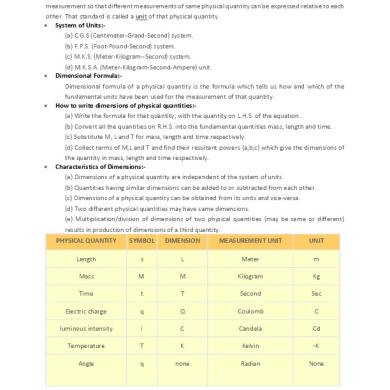Units And Measurements.docx
This document was uploaded by user and they confirmed that they have the permission to share it. If you are author or own the copyright of this book, please report to us by using this DMCA report form. Report DMCA
Overview
Download & View Units And Measurements.docx as PDF for free.
More details
- Words: 749
- Pages: 5
In order to make the measurement of a physical quantity we have, first of all, to evolve a standard for that measurement so that different measurements of same physical quantity can be expressed relative to each other. That standard is called a unit of that physical quantity. System of Units:(a) C.G.S (Centimeter-Grand-Second) system. (b) F.P.S. (Foot-Pound-Second) system. (c) M.K.S. (Meter-Kilogram--Second) system. (d) M.K.S.A. (Meter-Kilogram-Second-Ampere) unit. Dimensional Formula:Dimensional formula of a physical quantity is the formula which tells us how and which of the
fundamental units have been used for the measurement of that quantity. How to write dimensions of physical quantities:(a) Write the formula for that quantity, with the quantity on L.H.S. of the equation. (b) Convert all the quantities on R.H.S. into the fundamental quantities mass, length and time. (c) Substitute M, L and T for mass, length and time respectively. (d) Collect terms of M,L and T and find their resultant powers (a,b,c) which give the dimensions of the quantity in mass, length and time respectively. Characteristics of Dimensions:(a) Dimensions of a physical quantity are independent of the system of units. (b) Quantities having similar dimensions can be added to or subtracted from each other. (c) Dimensions of a physical quantity can be obtained from its units and vice-versa. (d) Two different physical quantities may have same dimensions. (e) Multiplication/division of dimensions of two physical quantities (may be same or different) results in production of dimensions of a third quantity. PHYSICAL QUANTITY
SYMBOL
DIMENSION
MEASUREMENT UNIT
UNIT
Length
s
L
Meter
m
Mass
M
M
Kilogram
Kg
Time
t
T
Second
Sec
Electric charge
q
Q
Coulomb
C
luminous intensity
I
C
Candela
Cd
Temperature
T
K
Kelvin
Angle
q
none
Radian
K
o
None
Mechanical Physical Quantities (derived) PHYSICAL QUANTITY
SYMBOL
DIMENSION
MEASUREMENT UNIT
UNIT
Area
A
L2
square meter
m2
Volume
V
L3
cubic meter
m3
velocity
v
L/T
meter per second
m/sec
angular velocity
w
T-1
radians per second
1/sec
acceleration
a
LT-2
meter per square second
m/sec2
angular acceleration
a
T-2
radians per square
1/sec2
second Force
F
MLT-2
Newton
Kg m/sec2
Energy
E
ML2T-2
Joule
Kg m2/sec2
Work
W
Joule
Kg m2/sec2
Joule
Kg m2/sec2
ML2T-2 Heat
Q ML2T-2
Torque
t
ML2T-2
Newton meter
Kg m2/sec2
Power
P
ML2T-3
watt or joule/sec
Kg m2/sec3
Density
D or ρ
ML-3
kilogram per
Kg/m3
cubic meter pressure
P
ML-1T-2
Newton per square
Kg m-1/sec2
meter impulse
J
MLT-1
Newton second
Kg m/sec
Inertia
I
ML2
Kilogram square meter
Kg m2
C
lumen (4Pi candle for point source)
cd sr
CL-2
lumen per
cd sr/m2
luminous
f
flux illumination
E
square meter entropy
S
ML2T-2K-1
Volume
Q
L3T-1
rate of flow
joule per degree
Kg m2/sec2K
cubic meter
m3/sec
per second
kinematic
n
L2T-1
viscosity
square meter
m2/sec
per second
dynamic
m
ML-1T-1
viscosity
Newton second
Kg/m sec
per square meter
specific
g
ML-2T-2
weight
Newton
Kg m-2/sec2
per cubic meter Electrical Physical Quantities (derived)
Electric
I
QT-1
Ampere
C/sec
current emf, voltage,
E
ML2T-2Q-1
Volt
Kg m2/sec2C
R
ML2T-1Q-2
ohm
Kgm2 /secC2
s
M-2L-2TQ2
mho
secC2/Kg m3
capacitance
C
M-1L-2T2 Q2
Farad
sec2C2/Kgm2
inductance
L
ML2Q-2
Henry
Kg m2 /C2
Current density
J
QT-1L-2
ampere per
C/sec m2
potential resistance or impedance Electric conductivity
square meter Charge density
magnetic flux,
r
B
QL-3
MT-1Q-1
Magnetic induction magnetic
coulomb per cubic meter weber per
C/m3
Kg/sec C
square meter H
QL-1T-1
ampere per meter
C/m sec
A
MLT-1Q-1
weber/meter
Kg m/sec C
E
MLT-2Q-1
volt/meter or
Kg m/sec2 C
intensity magnetic vector potential Electric field intensity
newton/coulomb
Electric displacement
D
QL-2
coulomb per square meter
C/m2
permeability
m
MLQ-2
henry per meter
Kg m/C2
permittivity,
e
T2Q2M-1L-3
dielectric constant
K
M0L0T0
frequency
f or n
T-1
angular frequency
W
T-1
Wave length
l
L
farad per meter
sec2C2/Kgm3
None
None
Hertz
sec-1
radians per second
Meters
sec-1
M
Principle of homogeneity:It states that “ the dimensional formulae of every term on the two sides of a correct relation must be same.” Types of error:(a) Constant errors:- An error is said to be constant error if it affects, every time, a measurement in
a similar manner. (b) Systematic errors:- Errors which come into existence by virtue of a definite rule, are called systematic errors. (c) Random error or accidental error:- Error which takes place in a random manner and cannot be associated with a systematic cause are called random or accidental errors. (d) Absolute error:Relative Error:-
Percentage Error:-
fundamental units have been used for the measurement of that quantity. How to write dimensions of physical quantities:(a) Write the formula for that quantity, with the quantity on L.H.S. of the equation. (b) Convert all the quantities on R.H.S. into the fundamental quantities mass, length and time. (c) Substitute M, L and T for mass, length and time respectively. (d) Collect terms of M,L and T and find their resultant powers (a,b,c) which give the dimensions of the quantity in mass, length and time respectively. Characteristics of Dimensions:(a) Dimensions of a physical quantity are independent of the system of units. (b) Quantities having similar dimensions can be added to or subtracted from each other. (c) Dimensions of a physical quantity can be obtained from its units and vice-versa. (d) Two different physical quantities may have same dimensions. (e) Multiplication/division of dimensions of two physical quantities (may be same or different) results in production of dimensions of a third quantity. PHYSICAL QUANTITY
SYMBOL
DIMENSION
MEASUREMENT UNIT
UNIT
Length
s
L
Meter
m
Mass
M
M
Kilogram
Kg
Time
t
T
Second
Sec
Electric charge
q
Q
Coulomb
C
luminous intensity
I
C
Candela
Cd
Temperature
T
K
Kelvin
Angle
q
none
Radian
K
o
None
Mechanical Physical Quantities (derived) PHYSICAL QUANTITY
SYMBOL
DIMENSION
MEASUREMENT UNIT
UNIT
Area
A
L2
square meter
m2
Volume
V
L3
cubic meter
m3
velocity
v
L/T
meter per second
m/sec
angular velocity
w
T-1
radians per second
1/sec
acceleration
a
LT-2
meter per square second
m/sec2
angular acceleration
a
T-2
radians per square
1/sec2
second Force
F
MLT-2
Newton
Kg m/sec2
Energy
E
ML2T-2
Joule
Kg m2/sec2
Work
W
Joule
Kg m2/sec2
Joule
Kg m2/sec2
ML2T-2 Heat
Q ML2T-2
Torque
t
ML2T-2
Newton meter
Kg m2/sec2
Power
P
ML2T-3
watt or joule/sec
Kg m2/sec3
Density
D or ρ
ML-3
kilogram per
Kg/m3
cubic meter pressure
P
ML-1T-2
Newton per square
Kg m-1/sec2
meter impulse
J
MLT-1
Newton second
Kg m/sec
Inertia
I
ML2
Kilogram square meter
Kg m2
C
lumen (4Pi candle for point source)
cd sr
CL-2
lumen per
cd sr/m2
luminous
f
flux illumination
E
square meter entropy
S
ML2T-2K-1
Volume
Q
L3T-1
rate of flow
joule per degree
Kg m2/sec2K
cubic meter
m3/sec
per second
kinematic
n
L2T-1
viscosity
square meter
m2/sec
per second
dynamic
m
ML-1T-1
viscosity
Newton second
Kg/m sec
per square meter
specific
g
ML-2T-2
weight
Newton
Kg m-2/sec2
per cubic meter Electrical Physical Quantities (derived)
Electric
I
QT-1
Ampere
C/sec
current emf, voltage,
E
ML2T-2Q-1
Volt
Kg m2/sec2C
R
ML2T-1Q-2
ohm
Kgm2 /secC2
s
M-2L-2TQ2
mho
secC2/Kg m3
capacitance
C
M-1L-2T2 Q2
Farad
sec2C2/Kgm2
inductance
L
ML2Q-2
Henry
Kg m2 /C2
Current density
J
QT-1L-2
ampere per
C/sec m2
potential resistance or impedance Electric conductivity
square meter Charge density
magnetic flux,
r
B
QL-3
MT-1Q-1
Magnetic induction magnetic
coulomb per cubic meter weber per
C/m3
Kg/sec C
square meter H
QL-1T-1
ampere per meter
C/m sec
A
MLT-1Q-1
weber/meter
Kg m/sec C
E
MLT-2Q-1
volt/meter or
Kg m/sec2 C
intensity magnetic vector potential Electric field intensity
newton/coulomb
Electric displacement
D
QL-2
coulomb per square meter
C/m2
permeability
m
MLQ-2
henry per meter
Kg m/C2
permittivity,
e
T2Q2M-1L-3
dielectric constant
K
M0L0T0
frequency
f or n
T-1
angular frequency
W
T-1
Wave length
l
L
farad per meter
sec2C2/Kgm3
None
None
Hertz
sec-1
radians per second
Meters
sec-1
M
Principle of homogeneity:It states that “ the dimensional formulae of every term on the two sides of a correct relation must be same.” Types of error:(a) Constant errors:- An error is said to be constant error if it affects, every time, a measurement in
a similar manner. (b) Systematic errors:- Errors which come into existence by virtue of a definite rule, are called systematic errors. (c) Random error or accidental error:- Error which takes place in a random manner and cannot be associated with a systematic cause are called random or accidental errors. (d) Absolute error:Relative Error:-
Percentage Error:-
Related Documents

Units
December 2019 45
Units
May 2020 27
Units
August 2019 49
Units
October 2019 35
Units
June 2020 20
Units
November 2019 27More Documents from ""

Sharada Tilakam - Mukund Jha Bakshi.pdf
July 2020 5
Technical In.docx
July 2020 0
Millets.docx
July 2020 0

